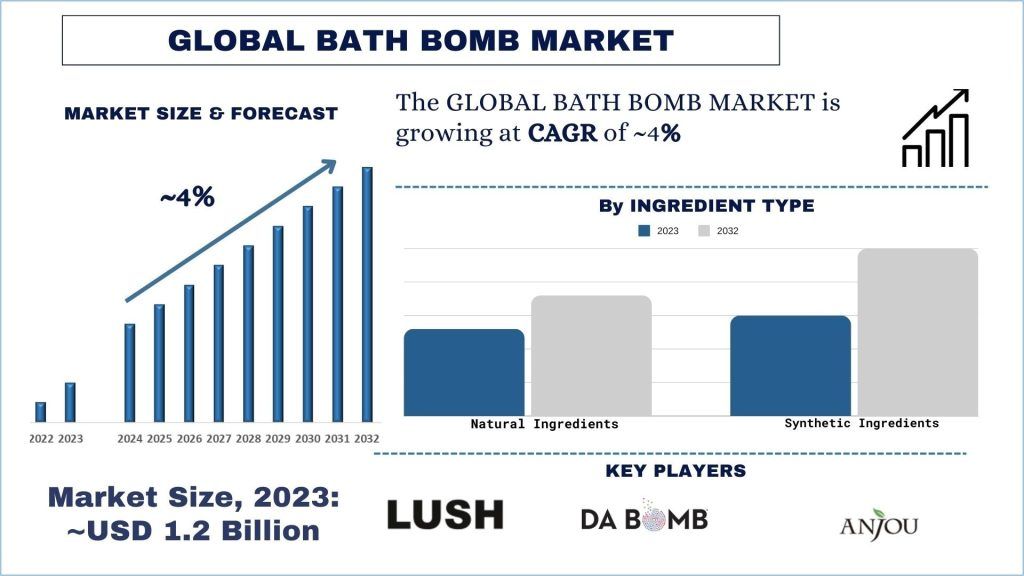
沐浴球市场规模与预测
2023年沐浴球市场估值为约12亿美元,预计在预测期内(2024-2032年)将以约4%的强劲复合年增长率增长。这归功于对可持续个人护理产品需求的不断增长。
沐浴球市场分析
近年来,在消费者对自我护理、健康和天然美容产品的兴趣日益浓厚的推动下,沐浴球市场实现了显著增长。消费者对自我护理和健康习惯的日益关注推动了对沐浴球的需求。此外,对个人护理产品中天然和有机成分日益增长的偏好也影响了沐浴球的配方。公司合作和创新产品发布也推动了该行业的发展。
例如,2024年5月,Lush推出了新版系列,以庆祝奈飞(Netflix)的《布里奇顿》新一季的上映。
此外,2024年3月,Lush与《怪物史莱克》系列合作推出了一个新系列。
例如,2022年9月,Lush与Alice’s Arc合作,以帮助扩大关于儿童癌症的信息,并筹集急需的资金,用于投资非动物试验的横纹肌肉瘤研究。
沐浴球市场趋势
本节讨论了由我们的研究专家团队确定的、影响沐浴球市场各个细分市场的关键市场趋势。
线下分销渠道正在改变行业
线下分销也构成了沐浴球市场相当大的比例,因为一些传统主义者有直接购买产品的购物狂倾向。没有交货停机时间使消费者更容易。一些细分市场例子包括店内促销、产品演示、抽样计划和销售点展示等等,这些都有助于行业的发展。因此,对沐浴球的这种需求示意性地表明,虽然买家圈子已经在网上扩大,但仍然存在着重要的线下存在。这些杠杆带来了优势,例如实体店可以提供的即时购买和个性化客户关注。关于线下营销的好处,它也有助于提高品牌知名度、建立信任和促进沐浴球的销售。例如,2023年4月,总部位于美国的Hairitage by Mindy McKnight是包容性护发领域的先驱,宣布通过推出最新的沐浴与身体护理系列来扩展到新的类别,该系列在沃尔玛独家销售。沐浴与身体护理系列包括六款产品,有四种香薰香味组合和三种新的香味组合。它利用各种精油来提供终极的香味和护理体验。
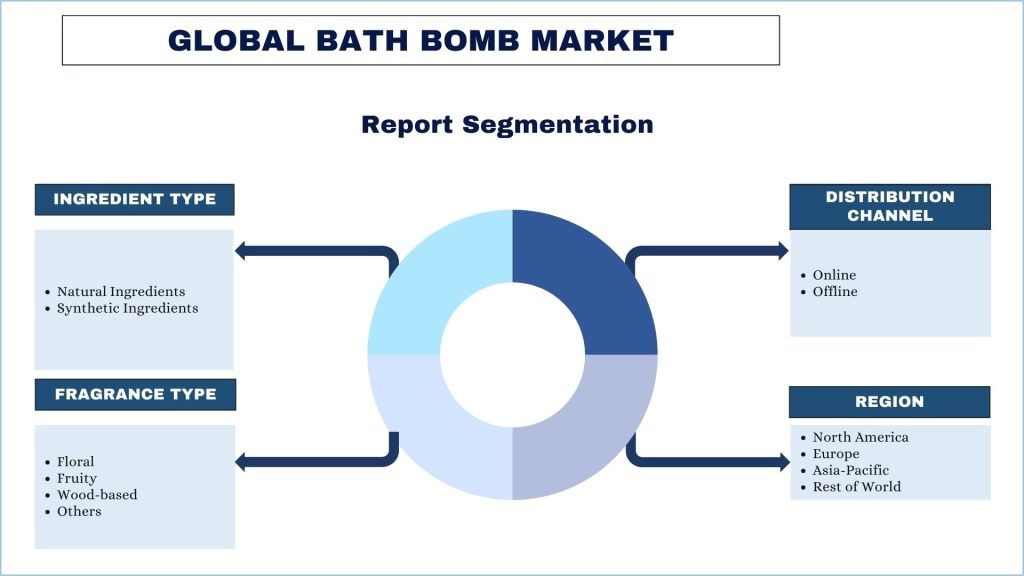
预计北美在预测期内将以显著的复合年增长率增长
在北美,美国占据了市场的主要份额。该地区快速的城市化、对消费品行业不断增长的投资、由于对这些产品需求的不断增长而导致的个人护理产品消费的增加、创新的沐浴球制造以及众多市场参与者的存在是推动该国市场增长的主要因素。
2021年6月,总部位于加拿大的Eve & Co Incorporated的全资子公司Natural MedCo Ltd.向纽芬兰和拉布拉多以及萨斯喀彻温省的零售商运送了其首批新的大麻浸泡沐浴球“The Optimist CBD Bath Bomb”。
2021年1月,旧金山股权合伙人收购了天然美容产品制造企业Smith & Vandiver Corp.。总部位于加利福尼亚州的Smith & Vandiver Labs专门生产泡腾产品,如淋浴片和沐浴球。
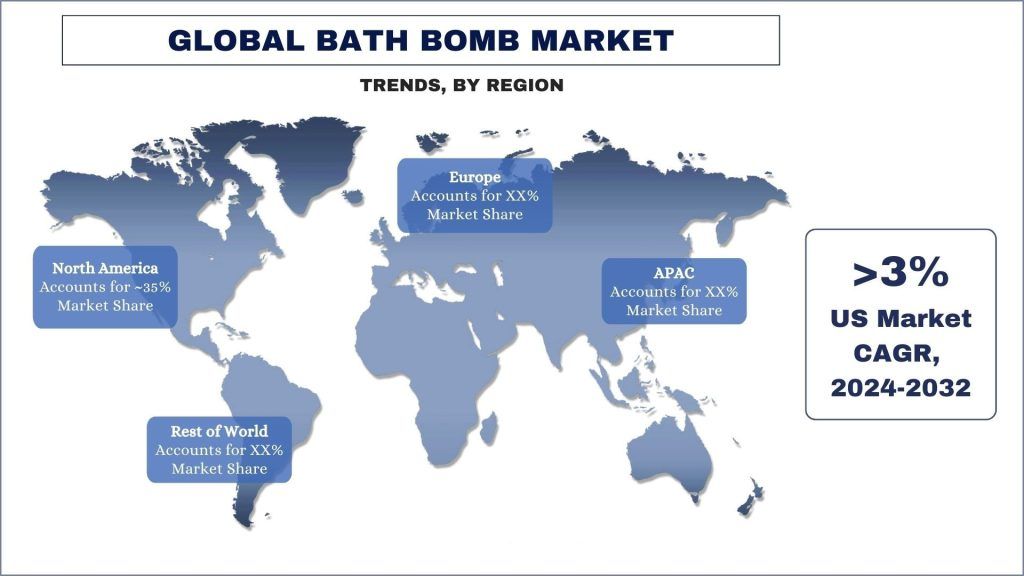
沐浴球行业概览
沐浴球市场竞争激烈,有几家全球和国际市场参与者。主要参与者正在采取不同的增长战略来增强其市场影响力,例如伙伴关系、协议、合作、新类型发布、地域扩张以及并购。市场上的一些主要参与者包括Lush Retail Ltd.; The Body Shop; The Village Company; Da Bomb; PDC Brands; Level Naturals; Lavender Boutique Farm; Musee Bath; LifeAround2Angels; Anjou.com。
2023年8月,Lush与芭比娃娃合作推出了一系列新的沐浴球。
2022年1月,Lush推出了新的情人节系列,其中包括沐浴球,包括新的沐浴球系列,该品牌“经典之作”茄子的更新、更大版本,以及“时髦”的Love Bug炸弹。
沐浴球市场报告覆盖范围
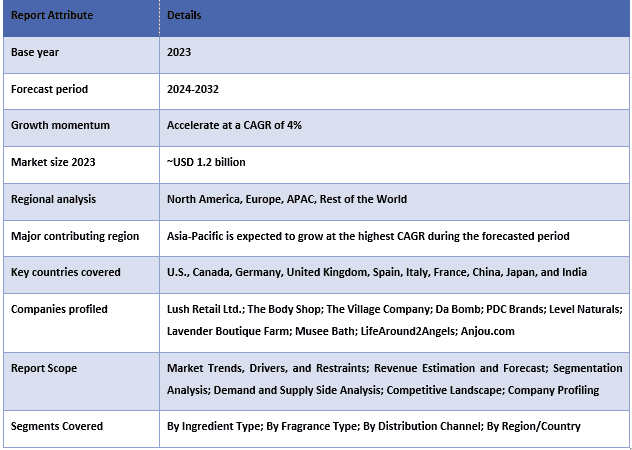
购买此报告的理由:
- 该研究包括由认证的关键行业专家验证的市场规模和预测分析。
- 该报告快速回顾了整个行业的整体表现。
- 该报告深入分析了主要行业同行,主要侧重于关键业务财务、类型产品组合、扩张战略和最新发展。
- 详细考察了行业内普遍存在的驱动因素、限制因素、主要趋势和机遇。
- 该研究全面涵盖了不同细分市场的市场。
- 深入的行业区域层面分析。
定制选项:
全球沐浴球市场可以根据需求或任何其他市场细分进行进一步定制。除此之外,UMI了解您可能拥有自己的业务需求,因此请随时与我们联系以获取完全符合您要求的报告。
目录
沐浴球市场分析(2024-2032)的研究方法
分析历史市场、估算当前市场以及预测全球沐浴球市场的未来市场,是创建和分析全球主要地区沐浴球采用情况的三个主要步骤。进行了详尽的二级研究,以收集历史市场数据并估算当前市场规模。其次,为了验证这些见解,考虑了大量的发现和假设。此外,还与全球沐浴球市场价值链中的行业专家进行了详尽的初步访谈。通过初步访谈对市场数据进行假设和验证后,我们采用了自上而下/自下而上的方法来预测完整的市场规模。此后,采用市场细分和数据三角测量方法来估算和分析与行业相关的细分市场和子细分市场的市场规模。详细方法如下:
历史市场规模分析
步骤 1:深入研究二级来源:
通过公司内部来源(如年度报告和财务报表、绩效演示文稿、新闻稿等)以及外部来源(包括期刊、新闻和文章、政府出版物、竞争对手出版物、行业报告、第三方数据库和其他可靠出版物)进行了详细的二级研究,以获得沐浴球市场的历史市场规模。
步骤 2:市场细分:
在获得沐浴球市场的历史市场规模后,我们进行了详细的二级分析,以收集主要地区不同细分市场和子细分市场的历史市场见解和份额。报告中包含的主要细分市场包括成分类型、香味类型、分销渠道和地区。此外,还进行了国家/地区层面的分析,以评估该地区测试模型的总体采用情况。
步骤 3:因素分析:
在获得不同细分市场和子细分市场的历史市场规模后,我们进行了详细的因素分析,以估算沐浴球市场的当前市场规模。此外,我们使用因变量和自变量(如成分类型、香味类型、分销渠道和沐浴球市场区域)进行了因素分析。我们对需求和供应侧情景进行了全面分析,考虑了全球沐浴球市场领域的顶级合作伙伴关系、并购、业务扩张和类型发布。
当前市场规模估算与预测
当前市场规模:基于以上 3 个步骤的可行见解,我们得出了当前市场规模、全球沐浴球市场的关键参与者以及细分市场的市场份额。所有需要的百分比份额分配和市场细分均使用上述二级方法确定,并通过初步访谈进行验证。
估算与预测:对于市场估算和预测,权重被分配给不同的因素,包括驱动因素和趋势、限制因素以及利益相关者可用的机会。在分析这些因素后,应用相关的预测技术,即自上而下/自下而上的方法,以得出全球主要市场不同细分市场和子细分市场的 2032 年市场预测。用于估算市场规模的研究方法包括:
- 该行业的市场规模,以收入(美元)和国内主要市场中沐浴球市场的采用率衡量
- 市场细分和子细分的所有百分比份额、拆分和细分
- 全球沐浴球市场中按类型划分的关键参与者。此外,这些参与者为在快速增长的市场中竞争而采取的增长战略。
市场规模和份额验证
主要研究:与主要地区的主要意见领袖 (KOL)(包括高层管理人员(CXO/VP、销售主管、营销主管、运营主管、区域主管、国家主管等))进行了深入访谈。然后总结主要研究结果,并进行统计分析以证明既定假设。主要研究的输入与二级研究结果相结合,从而将信息转化为可行的见解。
不同地区主要参与者的划分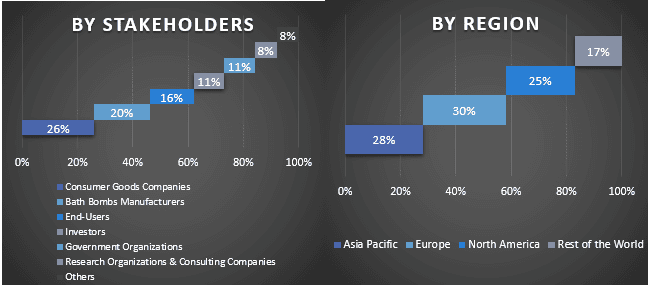
市场工程
采用数据三角测量技术来完成整体市场估算,并得出全球沐浴球市场每个细分市场和子细分市场的精确统计数据。在研究了全球沐浴球市场中成分类型、香味类型、分销渠道和地区等领域的各种参数和趋势后,将数据分成几个细分市场和子细分市场。
全球沐浴球市场研究的主要目标
研究中指出了全球沐浴球市场的当前和未来市场趋势。投资者可以获得战略见解,以根据研究中进行的定性和定量分析来确定其投资决策。当前和未来市场趋势确定了区域层面的市场整体吸引力,为行业参与者提供了一个利用未开发市场以受益于先行者优势的平台。该研究的其他定量目标包括:
- 分析沐浴球市场的当前和预测市场规模(以价值(美元)衡量)。此外,分析不同细分市场和子细分市场的当前和预测市场规模。
- 研究中的细分市场包括成分类型、香味类型、分销渠道和地区。
- 定义和分析沐浴球的监管框架
- 分析涉及各种中介机构的价值链,同时分析行业的客户和竞争对手行为。
- 分析主要地区沐浴球市场的当前和预测市场规模。
- 报告中研究的主要区域国家包括亚太地区、欧洲、北美和世界其他地区
- 沐浴球市场的公司概况以及市场参与者为在快速增长的市场中保持竞争力而采取的增长战略。
- 深入分析该行业的区域层面
常见问题 常见问题
Q1:浴球市场目前的市场规模和增长潜力是什么?
Q2:推动浴球市场增长的驱动因素有哪些?
Q3:按成分类型划分,哪个细分市场在浴球市场中占有最大的份额?
Q4:沐浴球市场有哪些新兴技术和趋势?
Q5:哪个地区将主导浴球市场?
相关 报告
购买此商品的客户也购买了










